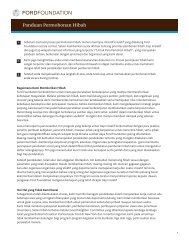Inclusive Scholarship: Developing Black Studies - Ford Foundation
Inclusive Scholarship: Developing Black Studies - Ford Foundation
Inclusive Scholarship: Developing Black Studies - Ford Foundation
You also want an ePaper? Increase the reach of your titles
YUMPU automatically turns print PDFs into web optimized ePapers that Google loves.
168 <strong>Inclusive</strong> <strong>Scholarship</strong>: <strong>Developing</strong> <strong>Black</strong> <strong>Studies</strong> in the United States<br />
for possible future <strong>Ford</strong> initiatives. In addition, it cannot be stressed enough<br />
that any review of the field, no matter how extensive, can only scratch the surface<br />
in terms of the myriad African American <strong>Studies</strong> units that one finds at<br />
U.S. universities and colleges and of the many scholars working in the field,<br />
often in relative obscurity and with scant resources.<br />
In his portion of Three Essays: <strong>Black</strong> <strong>Studies</strong> in the United States, the<br />
<strong>Ford</strong> <strong>Foundation</strong> report published in 1990, Robert L. Harris, Jr. breaks the<br />
development of the field down into four distinct phases. The first runs from<br />
the late nineteenth century until the 1940s and is marked by the rise of<br />
“early <strong>Black</strong> literary and historical associations.” Harris dates the second<br />
phase from the appearance of Gunner Myrdal’s study of African America<br />
in 1944, and contends that it was characterized by an ultimately unfortunate<br />
overemphasis on assimilationist models of racial interaction and on<br />
alleged <strong>Black</strong> “pathology” resulting from slavery and subsequent oppression.<br />
He suggests that the third stage, “from about the mid-1960s to the<br />
mid-1980s, was a period of legitimization and institutionalization.” The<br />
fourth, which <strong>Black</strong> <strong>Studies</strong> is just entering at the beginning of the final<br />
decade of the century, is one of “theoretical refinement and more sophisticated<br />
analysis and interpretation.” 2<br />
Although this scheme might imply a linear development of inevitable<br />
progress, Harris is quick to note the extent to which this last stage will depend<br />
upon institutional stability and growth in curricula and faculty resources.<br />
While the “theoretical sophistication” that Harris anticipated<br />
continues apace through the excellent and diverse work of a broad base of<br />
scholars, it is also clear that the structural stability requisite for institutionalization<br />
of this work has, at many institutions, not been achieved. This<br />
problem has resulted, in part, from the reluctance of some universities and<br />
colleges to develop a strategy for moving <strong>Black</strong> <strong>Studies</strong> units into the mainstream<br />
of the institutional structure. Some of these units occupy the same,<br />
often unique status as when they were created—this, often as a result of<br />
political pressure outside the normal academic structures of the school.<br />
Few of the units that started out as interdepartmental programs have<br />
achieved departmental status and, with that, the power and stability of departments.<br />
The units created as departments from the beginning are often

















